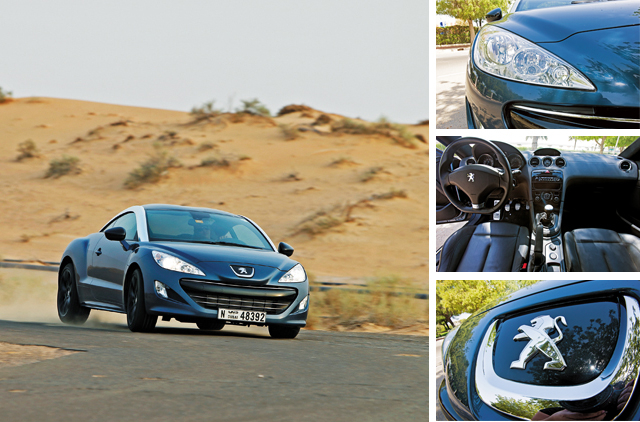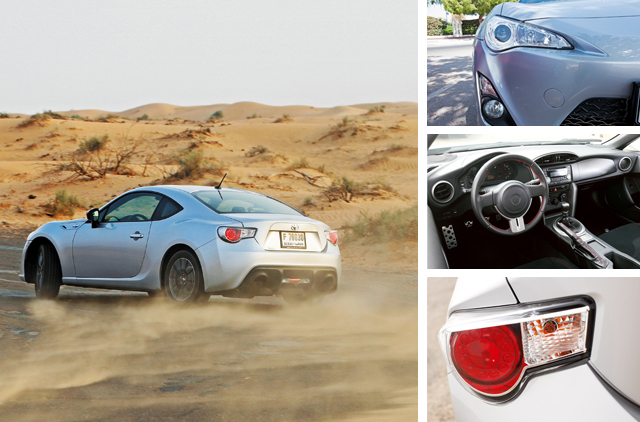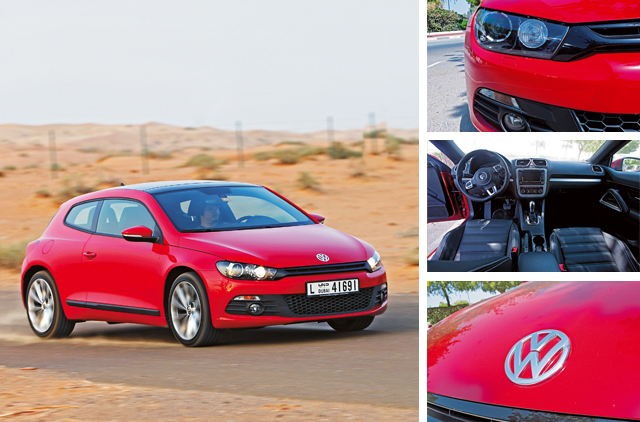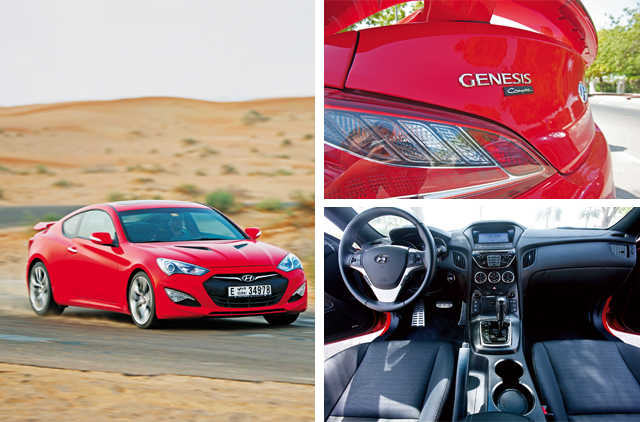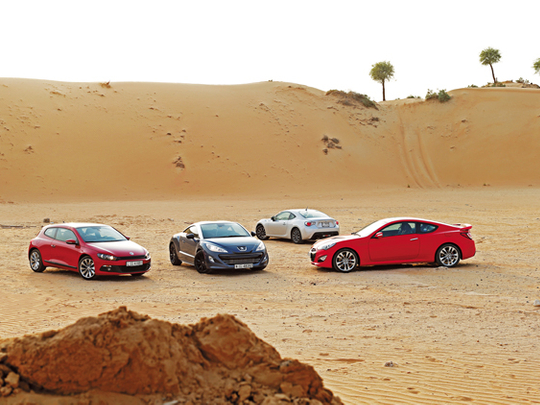
This feature almost didn’t happen. You were supposed to be reading all about the snooze-inducing virtues of five extremely beige mid-size family saloons. But we’ll leave that for next week… Make sure you bring plenty of coffee. There’s no caffeine necessary for this one. How can you not get excited about four sporty coupés enjoying a thrashing on a series of intertwined oil-field service roads? Our desert playground is littered with abrasive tarmac, changing surfaces, plenty of slow and winding turns, and some undulating straights too.
Immediately after we start handbrake-turning the front-wheel drives into some right-hand bends, a couple of hard hat-wearing heavies pay us a visit and politely ask us to get the heck off the oil field. But it’ll take more than a telling-off to tell us off. Calling the army to leave its checkpoint just on the other side of a dune will suffice. Thankfully it doesn’t get to that, as a friendly oil-field supervisor pays us a visit and advises us simply not to be seen by the boys in green.
“What if we just pretend you never saw us here?” we ask. “Good question,” he responds, laughs, and scurries off in his pick-up truck. We all climb our photographer Stefan’s first vantage point, a small dunette on the side of the road, and take a moment to enjoy the view of our play area for the day.
The toys are relaxing in a dirt lot waiting their turn and a go at the patchy, slippy blacktop: a 300bhp Hyundai Genesis Coupé with a V6 and rear-wheel drive, a 200bhp 1.6-litre front-driving Peugeot RCZ with a six-speed manual, an equally powerful Volkswagen Scirocco with a 2.0-litre turbo and DSG, and the 200bhp 2.0-litre naturally aspirated Toyota 86 boasting a stick shift ’box. All different ways of producing a wide smile on your face for well under 150 grand, but which smile has the best width-per-dirham ratio?
Peugeot RCZ
The Peugeot’s steering wheel is just a steering wheel. A rim, and three spokes. There are no stereo commands at three o’clock, and no cruise control or mute buttons at nine. No distractions, just a wheel. Granted the Toyota 86 also has just a steering wheel without cluttery multifunctional switches, but that’s because it’s so cheap it can’t really afford any. The Peugeot is very well equipped, with leather, stitched dash-top, cruise control, electric seats and a bunch of other stuff, but the first impression is that of a linear focus towards the simple act of driving.
Pitch the weighty steering into a turn and at first you won’t know whether this thing is all-wheel drive or front-wheel drive with a limited slip differential. In fact there is no LSD fitted to the front driven axle — that’s reserved for the upcoming 260bhp RCZ R — just clever electronics that mimic a mechanical system, and a chassis balance that rivals the Renaultsport Clio on purity and control.
With a weight of 1,421kg the RCZ is carrying 200kg over the 86 and 100kg over the Scirocco, and the tiny 1.6-litre turbocharged engine only manages a 0-100kph time of 7.6 seconds. But that’s missing the point. On its 235/40 R19 Continentals the Peugeot grips with unshakeable tenacity, refusing to push wide and instead lifting the inside rear wheel through its stiff chassis. In fact, the suspension can do with a slight drop and perhaps less damping as it’s cushy during a cruise and nicely absorbing over ruts and bumps.
As an exercise in lively, responsive and well-balanced front-wheel drive dynamics, the Peugeot RCZ breaks no new ground, but demonstrates that clever interpretations of an age-old formula can exhibit startlingly good handling. We can’t remember the last time we drove such a capable front-driver.
The well-tuned suspension is a simple MacPherson front with a torsion beam rear — typical FWD stuff — but the centre of gravity is low, the overhangs kept short for instant turn-in response, and the front and rear tracks considerably widened by 54mm and 72mm compared with the 308 on which it’s loosely based. The simple dimensional changes are the reason for the RCZ’s exceptional handling.
Its 1.6-litre turbo surprises with the amount of torque on offer too, as leaving the RCZ in sixth gear and stepping on it from 60kph results in linear and adequate progress thanks to 275Nm available from 1,400rpm.
There are downsides. The six-speed manual gearbox is rubbery, or maybe it’s just the abused test model, and the clutch pedal bites abruptly but late. If you don’t know what you’re doing you’ll go through a clutch every six months.
Lastly, however talented, as the smallest engined model here it is also the most expensive. And that’s a hard sell for a Peugeot, unfortunately.
Toyota 86
Second, third, still hard on the throttle, fourth, brake, back down to second through third — you never want to skip gears in the 86 — clutch-kick to swing the rear end wide on entry, step on it, ride the red line all the way through, third again, keep it planted, fourth… Repeat. Take every opportunity to change gears with the slick, short-throw manual ’box in the Toyota 86. Moments like this are all too rare these days.
Wring everything out of the torque-light 200bhp flat-four engine, keep the rev needle bouncing, focus with that steering wheel in your hands — it’s so responsive and sensitive that the slightest movement will have the 86’s lithe front end scrambling for roadside obstacles. You don’t get into the 86, you drop into it. It’s remarkably compact, low, and by far the lightest car here at 1,210kg.
Once cosy in the supportive, narrow seats, your legs extend straight out towards the ideally offset pedals. The narrow dash and upright steering wheel make the view out completely unobstructed, and the sharp wheel arch tops just edging into your view make for some perfect orientation points for placing the front wheels as precisely as possible.
Before you even get going, the 86 has you raring to go. Dip the clutch and it’s heavy, seemingly on its way out already at 9,000km in this tester. The bite, however, is smooth and there’s no need to ride the clutch out of junctions. With the traction and stability controls switched off the 86 will slither off the line every time, due in part to the base-spec model’s 16in wheels and worn tyres narrower than a space-saver.
You know what that means… Forget about power-oversteer: 200bhp isn’t enough even at this low weight, and the handbrake doesn’t play ball at corner entry either. Toyota build quality might be the envy of the world, but the 86’s interior seems to have been cobbled together with parts from the Japanese giant’s most unsavoury suppliers. It’s ideally designed with the driver in mind, but boy they couldn’t have made it cheaper if they tried. Every time I lightly yank on the e-brake to put an oversteering smile on my face, the entire leather-lined handbrake shroud comes away from its base.
A different approach is necessary in the incredibly well-balanced 86. Near a corner, downshift, and as you turn-in kick the clutch in violently with a single dip and let the laws of physics take over. No need to see-saw at the precise steering to find the balance; just let go of the rudder and allow it to unwind before catching it again, then gently correct, letting the chassis get back into line with minimal fuss. This is the easiest car to get into trouble with, but it’s also the easiest to get out of it.
The Toyota 86 is marvellously involving, asking the driver to constantly keep caning the engine, pushing the boundaries of its sorted chassis further and further. Don’t worry, the 86 can take it. It’s fetishist.
VW Scirocco
Since Volkswagen owns three of greatest marques in the world in Bentley, Audi and Lamborghini (let’s ignore Skoda for now…) you’d be forgiven for thinking the Scirocco should not just be the best car in this little group, but the best car, period. It ought to ooze class and sophistication, boast impressive technology and go quick enough to blur your vision.
Our Salsa Red turbocharged 2.0-litre four-pot test car had all of those attributes in its locker and it was arguably the best of the bunch as a daily driver. But as an out and out sportscar (minus the R badge) the present company might be a little too much for it. However, with an interior that basically embarrasses that of the bare bones 86 (it gets supple leather seats and funky shaped door handles) and with a wrestlers-like squat that blows away the stance of the RCZ, the Scirocco scores heavily in every department.
You could drive this hatch, which is basically a Golf GTi albeit with a totally different and far better looking body, every day of the week with a broad smile and the only time that would turn into a grimace would be when you’re trying to see out of the tiny rear window and when you’re changing lanes because the blind spots border on the dangerous. Other than that, this 210bhp beauty is a belter.
Even though 280Nm of torque (from just 1,700rpm, mind) is nothing compared to the 361Nm available in the Genesis, the front-wheel-drive VW feels aggressive, sounds raspy and has the ability to play tricks with your mind. You’d think it’s a lot quicker than the numbers suggest when you bury your right foot into the carpet. Its get up and go is impressive to say the least but like most front-wheel-drive cars, it suffers a little from torque steer.
Mated to the motor is the magical six-speed DSG and for maximum fun, the best thing to do with the lever is to leave it in Sport. The gear changes are sharp, the steering is precise and it handles nice and tight. Zipping in and out of lanes becomes the only way to drive this. Overall, the Scirocco is a solid and practical all-rounder, but give it an open road and it’ll hit 235kph and give you one great ride. But, this is a tough little group — can it hold its own here?
Hyundai Genesis Coupé
Right from the first time we drove the Genesis Coupé is 2009, we knew this car had the potential to change the Korean carmaker’s fortunes. Here was an upstart Hyundai that claimed and later proved that it can stand up to rivals that had decades of sportscar heritage behind them. And considering the giant strides Hyundai has since taken with every single model in its line-up, we were pretty sure it was just a matter of time before a vastly improved version of the sportscar surfaces.
The new Genesis is ages ahead of its predecessor in the looks department. The redesigned exterior and the upgraded interior with softer plastics replacing the old hard, tacky ones, there’s an overall more sophisticated air about the car. In fact, it’s arguably the best looking coupé of the lot.
Although for some reason, Hyundai Middle East chose to stick with the same 299bhp engine rather than the uprated 348bhp version available elsewhere, mated to a new eight-speed transmission, the 3.8-litre V6 still makes it the best endowed among the four. However, in comparison with the other three sportscars, the Genesis is heavy, and sadly, it feels heavy too, sort of offsetting the power advantage it seemingly had.
The predictable, precise and well-weighted hydraulic steering and the firm yet compliant suspension which has been recalibrated for better control and comfort, keep the Hyundai firmly planted and composed around fast corners while affording a comfortable ride at cruising speeds. Unfortunately though, Hyundai hasn’t done anything about one of the biggest complaints we had about the Genesis Coupé; the brakes.
The Brembos feel too squishy for a car that has 300 horses at its disposal, and it becomes all the more apparent when you drive it back to back with the other three, all of which boast some exceptionally good stoppers. When puttering around, the eight-speed automatic ’box goes about its business in a quiet, seamless manner, but once you step on it, it kicks down enthusiastically with the gear changes becoming more noticeable. You can shift cogs manually using the steering-wheel-mounted paddles, but don’t expect any excitement in the form of blips or pops from the muted V6.
Overall, the Hyundai Genesis Coupé remains a solid sportscar with a decent engine and great suspension, but in a group with superb contenders like the Toyota 86, the Peugeot RCZ and the Volkswagen Scirocco, it somehow feels a bit lacklustre.
Verdict
The Genesis Coupé has the smoothest power delivery here, however while it felt great in the company of a Ford Mustang, with this throng it’s just too heavy, clumsy, hesitant and slow to react in the corners. Meanwhile, the supremely engineered Scirocco feels like a sensible saloon in this company, rather than an edgy, sporty coupé. Its transmission and throttle map is either nowhere, or all-out, and its chassis has plenty of safe understeer dialed in. The ’Rocco’s strongest point is its premium ride and steering quality, which are composed rather than simply fun. As a daily driver it is perhaps the best car here, and if we were levelheaded maybe that’s what we should judge it on.
But we’re not levelheaded, which is why we chose to sneakily conduct this test on off-limits oil-field service roads. The RCZ captures the second spot, with its superbly tuned front-wheel drive chassis combined with a fairly well- put-together interior. The 1.6-litre motor is a torque-laden little thing, allowing for great highway economy and above-average response for a turbo lump. The RCZ’s biggest letdowns are twofold: a) the brand is still building its image and gaining the trust of the Middle East motorists, and b)it’s far too expensive.
The 86 wins this shoot-out hands down, for its combination of unrivalled chassis dynamics, eager character and a driving position that attaches you to the car almost to the point of some kind of perversion. In case you needed any more convincing, the 86 is the best sportscar this kind of money can buy. Now please excuse us — we see a bunch of angry men in green marching our way.


